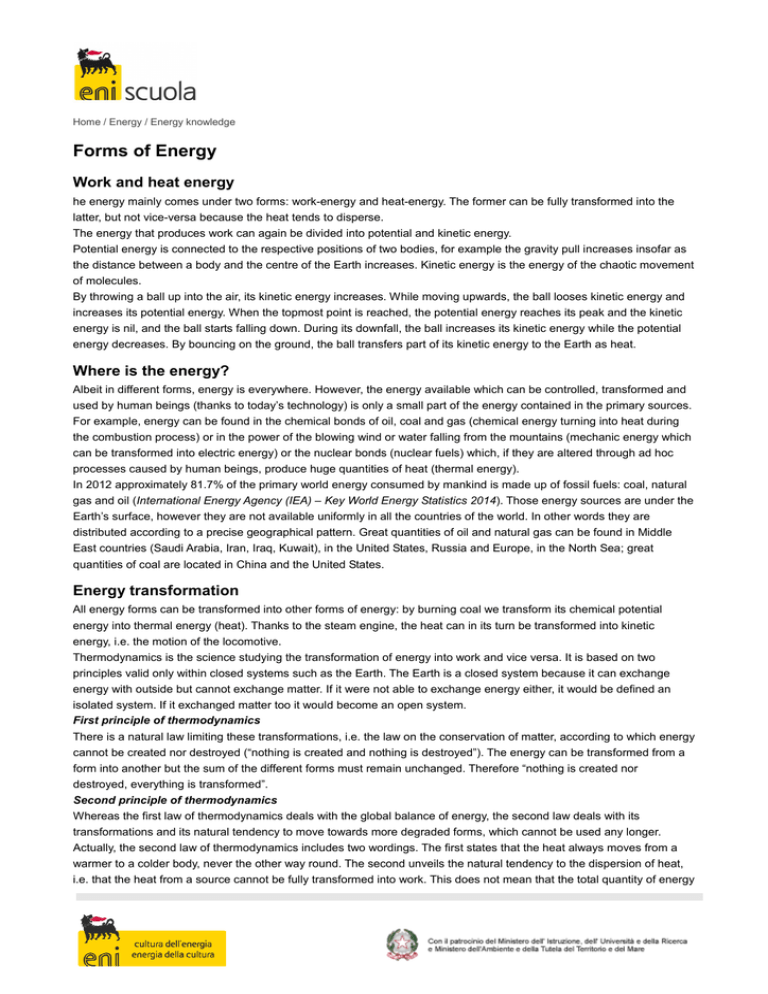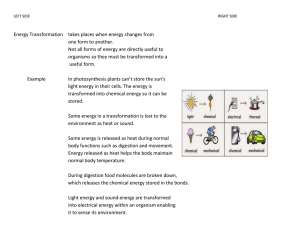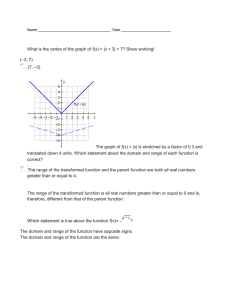Forms of Energy
advertisement

Home / Energy / Energy knowledge Forms of Energy Work and heat energy he energy mainly comes under two forms: work-energy and heat-energy. The former can be fully transformed into the latter, but not vice-versa because the heat tends to disperse. The energy that produces work can again be divided into potential and kinetic energy. Potential energy is connected to the respective positions of two bodies, for example the gravity pull increases insofar as the distance between a body and the centre of the Earth increases. Kinetic energy is the energy of the chaotic movement of molecules. By throwing a ball up into the air, its kinetic energy increases. While moving upwards, the ball looses kinetic energy and increases its potential energy. When the topmost point is reached, the potential energy reaches its peak and the kinetic energy is nil, and the ball starts falling down. During its downfall, the ball increases its kinetic energy while the potential energy decreases. By bouncing on the ground, the ball transfers part of its kinetic energy to the Earth as heat. Where is the energy? Albeit in different forms, energy is everywhere. However, the energy available which can be controlled, transformed and used by human beings (thanks to today’s technology) is only a small part of the energy contained in the primary sources. For example, energy can be found in the chemical bonds of oil, coal and gas (chemical energy turning into heat during the combustion process) or in the power of the blowing wind or water falling from the mountains (mechanic energy which can be transformed into electric energy) or the nuclear bonds (nuclear fuels) which, if they are altered through ad hoc processes caused by human beings, produce huge quantities of heat (thermal energy). In 2012 approximately 81.7% of the primary world energy consumed by mankind is made up of fossil fuels: coal, natural gas and oil (International Energy Agency (IEA) – Key World Energy Statistics 2014). Those energy sources are under the Earth’s surface, however they are not available uniformly in all the countries of the world. In other words they are distributed according to a precise geographical pattern. Great quantities of oil and natural gas can be found in Middle East countries (Saudi Arabia, Iran, Iraq, Kuwait), in the United States, Russia and Europe, in the North Sea; great quantities of coal are located in China and the United States. Energy transformation All energy forms can be transformed into other forms of energy: by burning coal we transform its chemical potential energy into thermal energy (heat). Thanks to the steam engine, the heat can in its turn be transformed into kinetic energy, i.e. the motion of the locomotive. Thermodynamics is the science studying the transformation of energy into work and vice versa. It is based on two principles valid only within closed systems such as the Earth. The Earth is a closed system because it can exchange energy with outside but cannot exchange matter. If it were not able to exchange energy either, it would be defined an isolated system. If it exchanged matter too it would become an open system. First principle of thermodynamics There is a natural law limiting these transformations, i.e. the law on the conservation of matter, according to which energy cannot be created nor destroyed (“nothing is created and nothing is destroyed”). The energy can be transformed from a form into another but the sum of the different forms must remain unchanged. Therefore “nothing is created nor destroyed, everything is transformed”. Second principle of thermodynamics Whereas the first law of thermodynamics deals with the global balance of energy, the second law deals with its transformations and its natural tendency to move towards more degraded forms, which cannot be used any longer. Actually, the second law of thermodynamics includes two wordings. The first states that the heat always moves from a warmer to a colder body, never the other way round. The second unveils the natural tendency to the dispersion of heat, i.e. that the heat from a source cannot be fully transformed into work. This does not mean that the total quantity of energy Home / Energy / Energy knowledge present in the universe is decreasing, rather that its ability to work is. The thermodynamic function assessing the degree of energy dispersion is called “entropy” . Entropy in the universe tends to increase to reach a state of balance in which the total degradation of energy is achieved corresponding to the complete inability to work. Fortunately, biological systems are open systems, which thanks to the incoming of energy from outside, restore the positive global energetic balance. Energy efficiency At this point the notion of efficiency is to be dealt with. As a matter of fact, energy resources are precious goods, which are to be used efficiently and effectively. A basic concept to assess the quality and waste of any human activity is efficiency. Efficiency assesses which part of the energy and materials making up any action or process was successful and which part was lost. Energetic transformations too always lead to some losses. The efficiency of an energetic transformation is measured by dividing useful energy (the difference between the energy input and dissipated or wasted energy) by the energy input. If the efficiency of an energetic transformation amounts to 60%, this means that out of 100 energy units included in a process, 60 were transformed into usable energy forms, whereas the other 40 are transformed into non-usable energy forms. Two meaningful examples can be produced as regards the efficiency of the petrol we use for our cars and the thermal transformations taking place in a thermoelectric power plant. When we travel by car less than one fifth of the chemical energy contained in the petrol is transformed into mechanic energy, i.e. motion. The remaining part is transformed into heat, which cannot be used any more and is dispersed through the radiator or is discharged through the exhaust gas or warms the passenger compartment. Another part of the energy produced is transformed into heat owing to the friction among gears and is dispersed. The total quantity of energy at the beginning and the end of the process does not change, whereas the its form is changed (from chemical energy to motion and heat) and generally degrades into forms which cannot be used to produce work any longer. In thermoelectric power plants (where fossil fuels are burned to produce electric energy the transformation and use of which by the final users is easier) the average efficiency amounts to 40%. This means the out of 100 energy units contained in coal, oil or natural gas, only 40 are transformed into electric energy, whereas the remaining 60 are transformed into low temperature heat which often cannot be used. In state-of-the-art thermoelectric power plants using natural gas, new technologies allow higher efficiency levels, i.e. approximately 65%.




